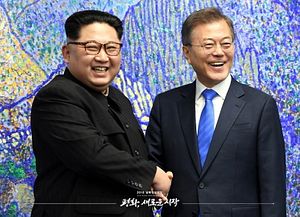In the aftermath of last week’s historic summit between South Korean President Moon Jae-in and North Korean leader Kim Jong-un, Korea-watchers and security commentators commonly have emphasised how much of the event was unsurprising and reminiscent of previous inter-Korean summits in 2000 and 2007.
Yes, we have been here before – twice – without attaining either peace on the peninsula or North Korea’s disarmament. Nevertheless, it doesn’t strike me as particularly useful to dwell on the Panmunjom parley’s familiarity and the declaration’s ensuing language.
Rather, important differences between this summit and its predecessors merit close attention.
The first is the summit’s timing. As I noted in my recent column, Moon has learned his lesson from Roh Moo-hyun’s 2007 meeting with Kim Jong-il, which took place late in the former South Korean president’s tenure. Roh, ultimately, was unable to see through the implementation of the meeting’s resolutions.
Moon, by contrast, has potentially set up an inter-Korean process that he can implement over the remaining four years of his term. His critics had argued that, given his share of the popular vote in the 2017 presidential election, he had lacked a mandate to proceed with bold action in this area.
Public opinion polling after the summit, however, showed that criticism to be off the mark. With nearly 90 per cent of South Koreans approving of the Panmunjom summit in recent surveys, it’s clear that Moon’s rapprochement enjoys support.
The second noteworthy difference between the Panmunjom meeting and its predecessors is the unprecedented level today of North Korea’s nuclear and ballistic missile sophistication.
At neither previous inter-Korean summit did Kim Jong-un’s father have the weapons necessary to threaten the U.S. homeland and potentially drive a wedge into the U.S.-South Korea alliance.
But the younger Kim does and he is not intent on unilaterally disarming what he described recently as his country’s “treasured sword of justice”.
Much coverage has fixated on the appearance of the word “denuclearisation” in the Panmunjom declaration. The word appears thrice in the statement’s third section. Revealingly, North Korea released its own English translation of the declaration in its state-run media, raising suspicions of differences in interpretation.
From a close reading of North Korea’s release, it is apparent that Pyongyang is positioning itself as a nuclear weapons power committed to global nuclear disarmament.
Indeed, recall that Kim, at his 2018 New Year’s Day address, called for the mass production of ballistic missiles and warheads. That directive remains compatible with the diplomatic outreach we’ve seen since.
Even Kim’s pledges to halt the testing of intercontinental-range ballistic missiles and to dismantle the Punggye-ri nuclear test site, delivered days before the inter-Korean summit, are compatible with his directive to continue the production of missiles and new warheads. So, while North Korea was far from a self-confident nuclear weapons power at the first two inter-Korean summits, that is no longer the case.
Unfortunately, the similarities with past summits ultimately are likely to be most apparent in the area of denuclearisation. The Panmunjom summit and the resulting declaration are not a watershed moment for the prospect of removing nuclear weapons from either North Korea or the Korean peninsula.
This reality, however, does not mean the commitments or declaration don’t matter. They do. Whereas in 2017 the United States and North Korea appeared to be on the brink of war amid an intense battle of words between U.S. President Donald Trump and Kim Jong-un, and a spate of North Korean missile tests and U.S. military muscle-flexing, the symbolism seen in Moon and Kim’s meeting has pivoted the peninsula in a more peaceful direction.
That, above all, is the primary result of the Panmunjom declaration. For the first time since Kim Jong-un assumed the leadership of North Korea, Seoul and Pyongyang have jointly agreed to a vision of inter-Korean peace.
Even as the text of their declaration may seem familiar, there is plenty that is new here.
This article first appeared in the South China Morning Post and is published here with kind permission.

































